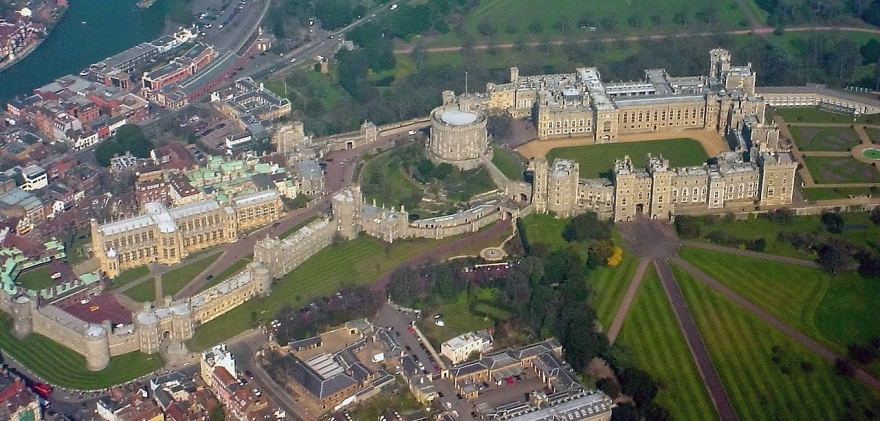The Susie Zone - Exploring Windsor Castle (May 2018)
Exploring Windsor Castle
by Susie J. Briscoe
 This is #5 in my series, in which we explore places where I have personal experience. This time, as promised last month, we will be going to Windsor Castle, where love has been in the air.
This is #5 in my series, in which we explore places where I have personal experience. This time, as promised last month, we will be going to Windsor Castle, where love has been in the air.
This is the oldest inhabited castle in the world, and it is the one which, to Her Majesty Queen Elizabeth II, feels the most like home.
During the war, whilst London was being blitzed with bombs on a nightly basis, The King and Queen, King George VI and Queen Elizabeth (later known on her husband’s death by the courtesy title of The Queen Mother), remained in London. When a bomb actually fell on Buckingham Palace, the Queen Mother was renowned for saying that she now felt able to look the East End (of London, which took the majority of the bombs in London) people in the eye, as in the bombs had now been visited on her own home.
The two princesses, now our present Queen and her late sister, Princess Margaret, were sent to the relative safety of Windsor Castle; I feel that this is the reason why it feels so much like home, as so many formative years were spent there, bringing lots of happy family memories.
The wedding of HRH Prince Harry and Meghan Markle was held on 19 May 2018 in St. George's Chapel at Windsor Castle in the United Kingdom and, as this has been so topical, I thought it a good idea to take a virtual look at this magnificent building where HM The Queen spends most of her time these days.
As you will now be aware, I’m sure, this is where Miss Meghan Markle was transformed into HRH The Duchess of Sussex, the Dukedom being bestowed upon her husband the morning of their marriage.
These two young people are making a Fresh Start together and are already demonstrating the positive changes they will make in the world.
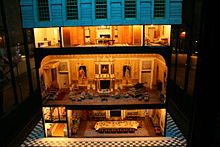 Now you may well be asking, how is this Castle personal to me? A good question and up until I was in my early 40s, the response would have been ‘I was taken there as a child to see the magnificent Doll’s House (pictured to the right) that had been a gift to HM Queen Mary’. At least, that was the most important memory I have from that first, of many, visits.
Now you may well be asking, how is this Castle personal to me? A good question and up until I was in my early 40s, the response would have been ‘I was taken there as a child to see the magnificent Doll’s House (pictured to the right) that had been a gift to HM Queen Mary’. At least, that was the most important memory I have from that first, of many, visits.
Then, because of all my charity work, I was invited to meet one of the people who actually live in one of the houses on the Lower Ward of the Castle to discuss the opportunity of a visit especially arranged for some American visitors – we were organising a tour of Southern England and arranging to visit places of special interest.
This is where it gets exciting for me, as I was allowed to drive in through the King Henry VIII Gate just off the main street of the town. No member of the public is given permission to do this in the ordinary way, so I was ecstatic.
I decided that our old Bentley was the only car that was up to the occasion – after all it had driven through the gates of Buckingham Palace, so this seemed a very natural choice – and parked in the Lower Ward, just adjacent to King George’s Chapel, now currently famous as being the place at which the dashing HRH Prince Harry married the girl of his dreams, Ms Markle, and where the royal couple first shared their happiness with not only those privileged enough to be there in person – again that would have been a special invitation only! – but to the world via the cameras which were filming everywhere.
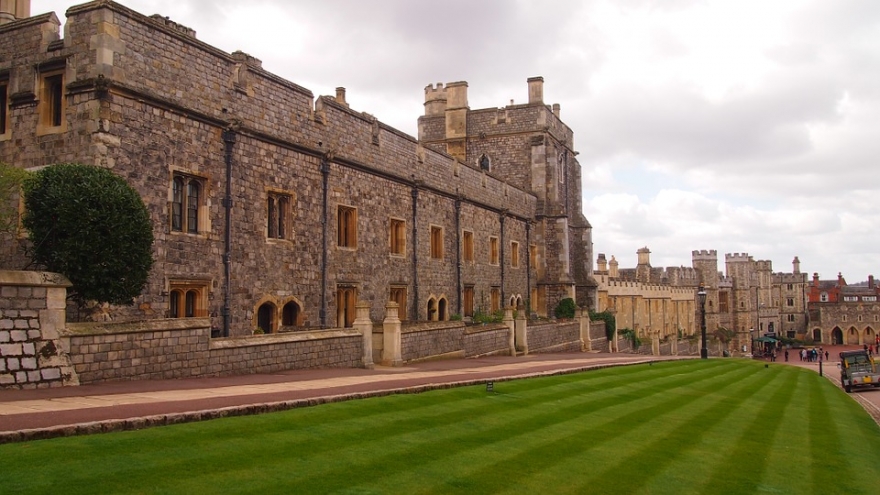 The Lower Ward, where I parked outside the house in which we were entertained, next to the fourth gate along, from the top, with the King Henry VIII Gate in the centre back of the picture, and St. George’s Chapel on the right and better seen below... The Lower Ward, where I parked outside the house in which we were entertained, next to the fourth gate along, from the top, with the King Henry VIII Gate in the centre back of the picture, and St. George’s Chapel on the right and better seen below... |
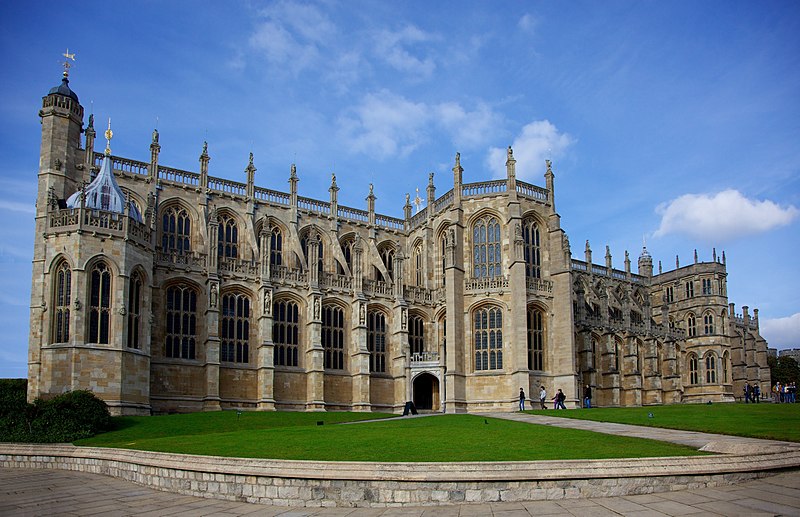 George's Chapel, begun in 1475 by Edward IV George's Chapel, begun in 1475 by Edward IV |
 Emerging for the first time as husband and wife, HRH Prince Harry, Duke of Sussex presents his wife to the world, watched by (l to r) her mother, Ms. Doria Ragland, HRH Prince Charles, and HRH The Duchess of Cornwall. |
Now, on to the history of Windsor Castle:
Windsor Castle is a royal residence at Windsor in the English county of Berkshire. It is notable for its long association with the English and later British royal family and for its architecture.
|
An aerial view of the castle: (l to r) the Lower Ward, the Middle Ward and Round Tower, the Upper Ward, with the Long Walk in the lower right-hand corner. The River Thames can be seen in the upper left of the picture. |
The original castle was built in the 11th century after the Norman invasion of England by William the Conqueror. Since the time of Henry I, it has been used by the reigning monarch and is the longest-occupied palace in Europe.
The castle's lavish early 19th-century State Apartments were described by the art historian Hugh Roberts as "a superb and unrivaled sequence of rooms widely regarded as the finest and most complete expression of later Georgian taste". Inside the castle walls is the 15th-century St George's Chapel, considered by the historian John Martin Robinson to be "one of the supreme achievements of English Perpendicular Gothic" design.
Originally designed to protect Norman dominance around the outskirts of London and oversee a strategically important part of the River Thames, Windsor Castle was built as a motte-and-bailey, with three wards surrounding a central mound. Gradually replaced with stone fortifications, the castle withstood a prolonged siege during the First Barons' War at the start of the 13th century.
Henry III built a luxurious royal palace within the castle during the middle of the century, and Edward III went further, rebuilding the palace to make an even grander set of buildings in what would become "the most expensive secular building project of the entire Middle Ages in England". Edward's core design lasted through the Tudor period, during which Henry VIII and Elizabeth I made increasing use of the castle as a royal court and centre for diplomatic entertainment.
Windsor Castle survived the tumultuous period of the English Civil War, when it was used as a military headquarters by Parliamentary forces and a prison for Charles I. At the Restoration of the monarchy in 1660, Charles II rebuilt much of Windsor Castle with the help of the architect Hugh May, creating a set of extravagant Baroque interiors that are still admired.
After a period of neglect during the 18th century, George III and George IV renovated and rebuilt Charles II's palace at colossal expense, producing the current design of the State Apartments, full of Rococo, Gothic and Baroque furnishings. Queen Victoria made a few minor changes to the castle, which became the centre for royal entertainment for much of her reign.
Windsor Castle was used as a refuge by the royal family during the Luftwaffe bombing campaigns of the Second World War and survived a fire in 1992. It is a popular tourist attraction, a venue for hosting state visits, and the preferred weekend home of Elizabeth II.
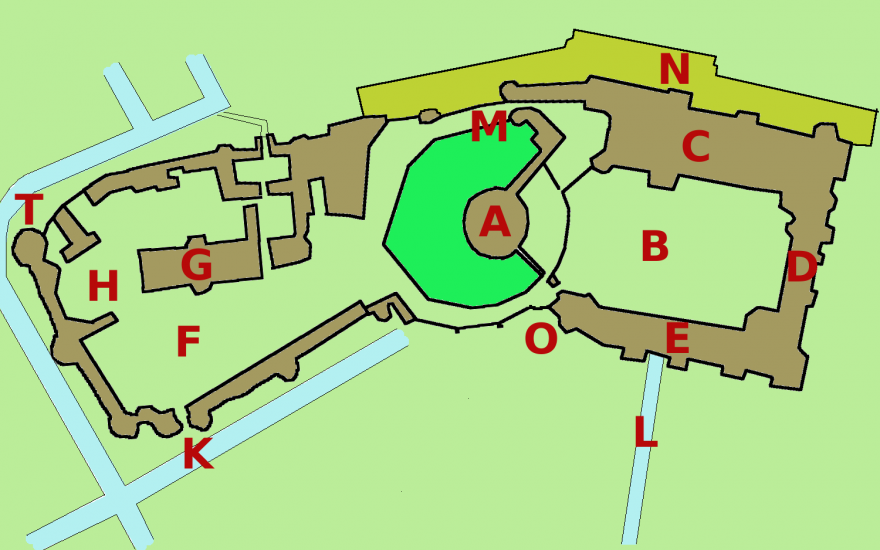
Key to plan
- A: The Round Tower – originally known as The Keep and is built on an earth mound.
- B: The Upper Ward, The Quadrangle (as this courtyard is known)
- C: The State Apartments
- D: Private Apartments, overlooking the East terrace
- E: South Wing, overlooking The Long Walk
- F: Lower Ward
- G: St. George's Chapel
- H: Horseshoe Cloister
- L: The Long Walk
- K: King Henry VIII Gate (principal entrance)
- M: Norman Gate
- N: North Terrace
- O: Edward IV Tower
- T: The Curfew Tower
Source: Wikipedia, with additional material by SJB
Don’t forget to share with me what you discovered during this month and let me know if I may share it within this newsletter next month.
